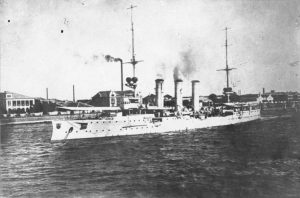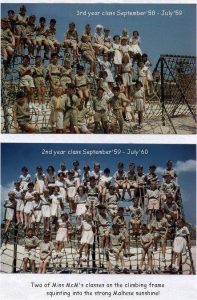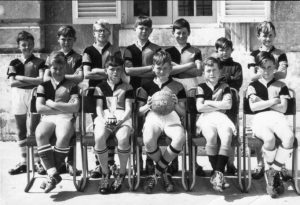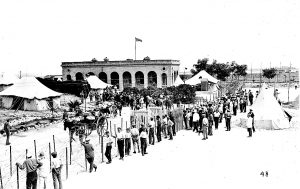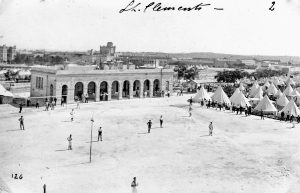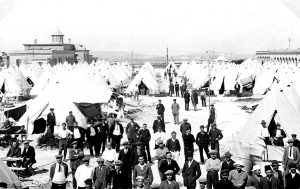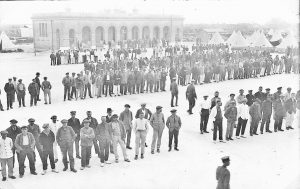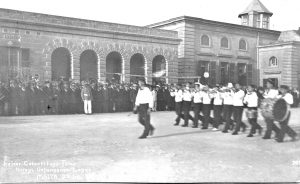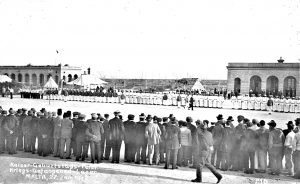The Verdala Story
From the Past to the Present
The Defensive Walls
- 30th December 1638 – The first stone of the Firenzuola Lines was laid by Grand Master Lascaris. These later became known as the Margherita Lines. The oldest part of these walls is the Verdala Gate opposite the school entrance
- 1670 – Grand Master Cotoner contributed generously out of his own personal resources for the building of the Cottonera Lines. The project was started on 28th August 1670. In Żabbar Gate there is a statue of Grand Master Cotoner
- 1697 – Margherita Lines works were continued by Grand Master Perellos
- 1720 – Grand Master Zondadari had to continue the walls when Perellos died
- 1736 – The Margherita Lines were finished by Grand Master Vilhena
- It took 98 years to build the Margherita Lines
The French in Malta
- June 9th, 1798 – Napoleon arrived in Malta with 472 ships and the army landed the next day
- June 11th, 1798 – Grand Master Hompesch surrendered
- September, 2nd 1798 – The Maltese revolted against the French
- September, 25th 1798 – Nelson arrived and put Alexander Ball in charge of the campaign to overcome the French, who were still inside Valletta and the Cottonera Lines. The French had their guns on the Cottonera Lines that is at the bottom of the football field
- September, 5th 1800 – The French surrendered
The Victorian Fortress of Verdala
- 1814 – With the Treaty of Paris, Malta became officially part of the British Empire
- 1853 – The British decided to build the Verdala Barracks behind the old Verdala Gate and they also made a new gate leading into Cospicua. Above this gate there is the Royal Coat of Arms and the date
- 1854 – The British decided to build a big fortress in front of the barracks. Evidence suggests that the fortress was designed by Major General Sir George Judd Harding K.C.B., R.E. Captain A.D. Craigle R.E. arrived with the 4th Company Royal Sappers and Miners to start the building
The Construction Site
- 1854 – This is the whole area on which the school now stands. Two sets of high walls were built from Verdala Barracks to St Clement’s Bastion on the Cottonera Lines. The area between the walls was levelled off for the erection of new buildings. This was not finished until 1860
- Verdala walls have 384 rifle slits and there are casemates for cannons on each side. The guns were kept in the tunnels which run along the inside of the bastion walls. The tunnels were also used for storing gunpowder and ammunition. Verdala became the main powder store for the Mediterranean Fleet of Britain. Water tanks were built to flood the ammunition stores in case of fire. The main tank under the playground holds more than a million gallons of water. The tunnels are no longer used for storing gunpowder
Regiments stationed at Verdala (The evidence of all this are the badges carved on the roof tops.)
- 1876 – 2nd Battalion North Staffordshire
1880-84 – 1st Battalion South Staffs
1887-89 – 1st Battalion Bedfordshire Signallers
1890-91 – 1st Battalion Bedfordshire Signallers
1892 – 2nd Battalion Connaught Rangers
1893-95 – 1st Battalion North Staffs
1896-98 – Duke of Wellington’s
1907-08 – 1st Battalion Connaught Rangers Signallers
World War I
Some German prisoners-of-war were also at Verdala barracks prison camp. One of these was Karl Doenitz, who was to become the Commander in Chief of the German Navy during the Second World War, and was to succeed Hitler as the head of Germany. Others were officials of the German war ship Emden. Karl Doenitz succeeded Hitler as Chancellor for a very limited span of time. Other prisoners-of-war were Prince Franz Josef Hohenzollern and Captain Karl Friedrich Max von Muller.
1920 – Verdala, Home to White Russian Officers
The White Movement, known as the White Army or White Guard and whose members are known as Whites or White Russians comprised some of the Russian forces, both political and military, which opposed the Bolsheviks after the October Revolution and fought against the Red Army during the Russian Civil War from 1918 to 1921.
It stood in contradistinction to the Reds – the revolutionary Red Army who supported the Soviets and Communism.
Second, the word white had monarchist associations; historically each Russian Tsar was solemnly called the White Tsar, and the monarchist ideal during the civil war was known as the White Idea.
- Aerial View Of Verdala Retrenchment
- Karl Doenitz
- SMS Emden (1908)
- Historical Graffiti along the Retrenchment Walls – Photo 1
- Historical Graffiti along the Retrenchment Walls – Photo 2
- Royal Navy School Photo
- Soccer Team (1965)
Tracing the History of RNS Verdala – Up to the 2nd World War
- The Dockyard School at the dockyard (1800 – 1904)
Senglea (1904 – 1929)
Senglea (1918) – School Certificate (or Matriculation) examination as well as for the Dockyard Apprentice Entry Examination
Malta Government School – St Clement ‘s Bastion in 1925, known as Verdala School
Dockyard School – St Clement’s Bastion in 1929
Dockyard Apprentices’ School or Dockyard Technical College remained within the Dockyard till its closure in 1960
Dockyard Children’s School (1929 – 1940)
St George’s Barracks (1940 – 1942)
World War II at Verdala
- 1940 – Verdala called HMS Euroclydon, and was used to house the crews of submarines Transit camp
1940-1944 – Prisoner of war camp
1943 – Naval Detention Centre
1945 – Demob. Centre; Servicemen en route for ship or flight to UK
What Happened Next?
- Dockyard Children’s School – Reopened at Ta’ Xbiex on 16th May 1946
- Army barracks at Tal-Ħandaq – 1947
- Naval Children’s School – 15th July 1947
- Verdala school was reopened – April 1949
- Change of title to “Royal Naval School” – 1952
- Possibility to house all the Primary section at Verdala – 1954
- Withdrawal of all British Service personnel and families from Malta in 1972
- Primaries reopened late in the Summer Term of 1972
- Royal Naval School closed in 1977
Political Decisions
- In 1971 Malta’s Prime Minister Dom Mintoff was asking for more money for the British base in Malta
- During the Christmas holidays of 1971, a few days before term was due to start, it was announced that all Service dependants were to leave Malta within two weeks and the schools would not reopen
- An agreement was reached by the Maltese and British political leaders
- Two terms later, in September 1972, the school reopened, somewhat reduced in size and with about 50% new staff and 75% new pupils
Final Closure of the School
- Numbers reached 600 by September 1973 and stayed about this level until early 1977 when the final rundown began to bite, causing numbers to decline steadily to the final total of just over 300
- School closed July 1977
The International School of Malta
- 1976 – The International School of Malta opened at Verdala for those students whose parents were in the oil exploration field. This school closed in June
- 1977-1978 – The School resumed under a new name that is The Verdala School of Malta
- October 1987 – The School was also open for Maltese students. Eventually the name of the school was changed to Verdala International School. This school moved to St Andrews, Malta
Verdala as a State School
- September 1984 – The Verdala Boys’ Secondary opened for ex-private school students whose parents had opted for a Government School. The Head of School was Mr Charles Chetcuti
- September 1985 – The Verdala Junior Lyceum was opened for those students who passed from the National Examinations set at the end of Primary Level. Mr Charles Chetcuti remained as headmaster of Verdala Junior Lyceum which eventually became known as Ġużeppi Despott Boys’ Junior Lyceum. A new block was built behind Block F to provide rooms for special lectures and the teaching of Information Technology
Information provided by Ms R. Debattista (Retired Head of Department, Geography)
School History Facts
The school is situated in one of the oldest historical sites of the island and its story goes as far back as the Great Siege, when the hill on which it stands served as a vantage point to the Turkish invaders to target Fort St. Michael and Fort St. Angelo. In 1638 the first stone was laid for the Firenzuola Lines, which eventually became know as the Margherita lines, with Verdala Gate, opposite the present school entrance, being the oldest part of these walls. In 1853 the British built the Verdala barracks behind this gate and later constructed a big fortress right across these barracks. It is on the grounds of this fortress that the school now stands. Starting out first as a state primary school (1924), then housing a dockyard class which provided students for the naval dockyard, it was later (1948) converted into a school for the children of British servicemen.
Verdala’s metamorphosis from a military installation to an educational one was completed when in 1972 it became The International School of Malta, catering for children of people employed overseas in the oil industry, and later also opening its doors to local students. 1984 and 1985 saw the concluding phase of this metamorphosis when the school became, first an area secondary school, and eventually, a Junior Lyceum, named after the local naturalist and ornithologist, Guzeppi Despott (1878-1936).
A Brief History of the Verdala Fortress in Cospicua, Malta
(Historical Research Article 2013)
The outer ring of fortifications in Cospicua surrounding the Santa Margerita Lines is known as the Cottonera Lines and these date back to 1670. They are so extensive that their construction exceeded the resources of the Knight’s Order and were never completed.
The Fort Verdala and the St.Clements’s Retrenchment were improvements the British built to span the undefended area between these two lines of fortifications. Fort Verdala has a unique structure, as one of its walls was incorporated into the 17th century Santa Margerita Lines to serve as a stronghold within the vast area of ground enclosed by the Firenzuola (Santa Margerita) and Cottonera enceintes.
By 1886 the Fort was armed mainly with 24 pounder smooth-bore Howitzers. This armament was removed in the 1890’s and thereafter the Fort was used as a large barrack complex to accommodate military personnel. It was also used as POW camp during WW1. After World War 2 it was used as naval stores. The extensive casemated barracks block of Fort Verdala is utilized today for public housing.
- Verdala Infants 1952
- Thought-to-be the St Clement’s Choral Society Meeting in the Club Room or Gym – photograph by Hiesinger
- An Overview of St Clement’s Camp looking from Verdala
- The Access Way into St Clement’s – photograph attributed to Hiesinger
- St Clement’s Football Match – photograph by Hiesinger
- A View of Man Tents looking towards the Verdala – photograph by Kofler
- A Formal Roll Call with Officers Inspecting
- 27 January 1917 – St Clement’s Parade Ground with Brass Band and Drums
- Tents
- 27 January 1917 St. Clement’s – Kaiser’s Birthday Gymnastics Display Team Line-up
Fort Verdala During World War 1
Malta’s role serving as a Prisoners of War camp mostly German and pro-German Austrian, Egyptian and Turkish prisoners – is history’s missing link. The most well-known German and Turkish POW’s were held in Malta, some for months while others for years or until the end of the war. The British used Malta as a huge concentration camp, an important role almost forgotten in the historic events of the first great world war.
This highly secretive operation by the British kept the Maltese in the dark. So much so, that even people living in the surrounding houses in Cospicua had no idea who the prisoners at Verdala Barracks were. The surrounding tent camps in the Cottonera area were completely cut off and no communication was allowed between camps. Some of the most illustrious German officers were locked up at the Verdala fortification in Cospicua. Other German sailors and soldiers were kept in tents outside Cospicua in St Clements’s Camp and at San Salvatore bastions in Kalkara.
Food was poor and the tents were not protective. Some Germans POW died from excessive heat or cold during their imprisonment in Malta. These were buried in the Kalkara War Graves cemetery. Two of the most famous German Navy captains who were imprisoned at Verdala were Franz Joseph Prinz von Hohenzollern and Karl Fredrick Max von Muller, the captain of the German raider ship “Emden” that sank many allied ships in the Far East. In Germany, Franz Joseph Prinz von Hohenzollern was a national hero. A postal stamp was issued in his honour. Being the first cousin of the German Kaiser, the British kept him in high esteem. His sister was the queen of Portugal.
Muller’s legendary ship, the “Emden”, was surrounded and scuttled on an island off Indonesia. He was secretly shipped to Malta on a British navy ship. He received a hero’s welcome from his fellow prisoners when he arrived at Verdala. Military and civilian prisoners considered him a great German hero. The British used the presence of Muller Franz Joseph Prinz von Hohenzollern at Fort Verdala as a propaganda ploy. They were both given their own room on an upper storey rather than a cell. They were free to exercise, write, keep domestic animals and mix with other prisoners. However, they refused these privileges knowing that their crews were held in terrible conditions outside Verdala. One German officer even had a chandelier fixed in his room. Through their influence, German officers were even allowed to print a magazine in German which they titled “Camp Nachrichten”. It was distributed to all prisoners at Verdala. The hand printed magazine often poked fun at their British captors with fine line drawings and text in the German language.
During the first months, security was very flexible. Most guards were Maltese soldiers and some prisoners were even escorted to visit Valletta for a short time. But all this changed when two prisoners, one German and one Austrian, escaped and disappeared from Malta. The British also discovered that some German prisoners were noting all naval movements in the Grand Harbour and somehow were sending the sensitive information back to Germany. Following this discovery, all windows with a panorama of the Grand Harbour were barred and covered.
The Germans protested with the British camp commandant and constantly complained about poor quality of food, lack of water and mail delivery from Germany. Some of these mass protests were so loud, that they could be heard as far as Valletta, where people complained they could not sleep because of the noise created by the German prisoners at night.
Karl Donitz another German officer also imprisoned at Verdala kept a low profile and more to himself. A young proud submarine captain, he spent his time locked up at Verdala barracks plotting to launch the feared U-Boat wolf pack tactics in case of another war. Under his command, during Second World War, hundreds of allied ships were sunk by German U-boats and 30,000 allied sailors and civilians were killed.
Ambitious and proud, Karl was to become a Grand Admiral and eventually Adolf Hitler’s successor after the Fuehrer committed suicide; a title he held just for 20 days, before his imprisonment by the victorious Allies. His connection with Malta during the First World War is an intriguing story of sheer courage and determination. An unbeaten German officer who lost his submarine and some of his crew in the Mediterranean, Donitz’s war exploits are still followed by thousands of people. On the internet site YouTube, there is a rare interview with Karl Donitz which was probably filmed some time before his death in Hamburg on Christmas eve of 1980. He explains that he was the captain of UB 68 when his submarine attacked a British convoy off Gozo. “It was a dark night on October 4, 1918 when we attacked and sank a British cargo ship. But as a single submarine we became too exposed and were hit and had to abandon the sub and scuttle her.” His chief engineer and six other crew members voluntary stayed in the sub to die for their Fatherland in order to make sure that the sub sank and did not fall in the enemy’s hands. “During my nine months imprisonment (in Malta), it dawned to me that submarines are more effective if they attack as a group.”
Secretive from his British captors, he continued to developed new tactics while a prisoner at Verdala. During WW2, under Donitz’s command, now an admiral, U-Boats were the most feared German weapons. They became known as the “wolf packs”.
But how did Donitz behave during his imprisonment at Verdala? Marc James Small from the Marine History Information Group mentions that Donitz was imprisoned in Malta when his submarine was sunk by the British some miles off the island. In prison he managed to convince the authorities that he was insane by playing with china dogs he purchased in the camp canteen. He was repatriated but arrived home too late to play a further role in WW1. Many believe that Donitz’s innocent looking toys helped him to plan his wolf pack submarine tactics. Before his death, although beaten by old age, Donitz stated that he had no regrets and would do the same if he had another chance, despite the fact that he lost both his sons in submarine warfare. Three out of every four German U-Boats never returned and were lost with their young crews. Many believe that considering the situation, the German U-boats fought hard but fair, and Donitz was punished for being too efficient.
In the Nuremberg trials, Donitz was accused of war crimes. He served 11 years and 8 months in Berlin- Spandau prison, quite a huge contrast from his previous prison in Malta. After his release in 1956, he went to live in a quite village outside Hamburg.
The only Maltese who can recall that he met Donitz is marine historian and owner of the only private marine museum in Malta, Victor Wickman. “Yes, I met him briefly. In his old age, he still showed the same pride of his golden sea sagas. He told me that he still remembers when he was a prisoner of war in Malta. He did not try to go into details, but he appreciated that he was treated quite well at Verdala Barracks.”
Another person, Stephen Petroni is a great collector of German war ‘souvenirs’, from old German patrol armed carriers to army uniforms and armaments used by German forces during the WW2. He has a collection of unique valuable rare documents connected with Verdala Barracks when used as prisoners of war camp during WW 1. Through his initiative, he wanted to reserve part of the Fort, still neglected and used as a rubbish dump, for restoration and exhibition projects. Stephen is convinced that if the true historical facts of Verdala’s role in the First World War are known in Germany, thousands will visit Malta just to see where their great grand German ancestors, captains and admirals were held as POW’s. However, he found no response from the local Government Authorities.
After more than 80 years, the huge building of Verdala has stood the test of time. The entrance door of the old fortifications is in a state of deep erosion, but the huge bastions and the inside quarters are reasonably in good conditions. From the outside, one can still see the thick iron bars that blocked the outside bastion windows. One wonders how many secrets were locked amongst the prisoners held on the inside. The grounds where the prisoners paraded and spent their free time is still there but covered with tarmac. The granite steps and stairs that lead to the upper cells are still original. When the barracks were transformed into a housing estate for Maltese families, the barracks suffered from constant rape of its original fortifications. No voices of protest were ever heard. Many facades were painted in different colours and aluminium doors and windows replaced the originals. Most residents were permitted to connect rooms destroying original walls to make room for bigger premises. It may be far too late to restore Verdala Barracks back to its old glory and its rightful place in the history books. As years rolled on, all captors and captives are all gone. For generations to come, there is not even one trace or memory dedicated to the illustrious German prisoners who walked the corridors of Verdala during their captivity in Malta. Some of the prisoners of Verdala changed the course of world history, but their presence at Verdala and other POW camps in Malta is completely forgotten.
Research article by Mr Martin Azzopardi sdc, school archivist
No posts to show yet!



